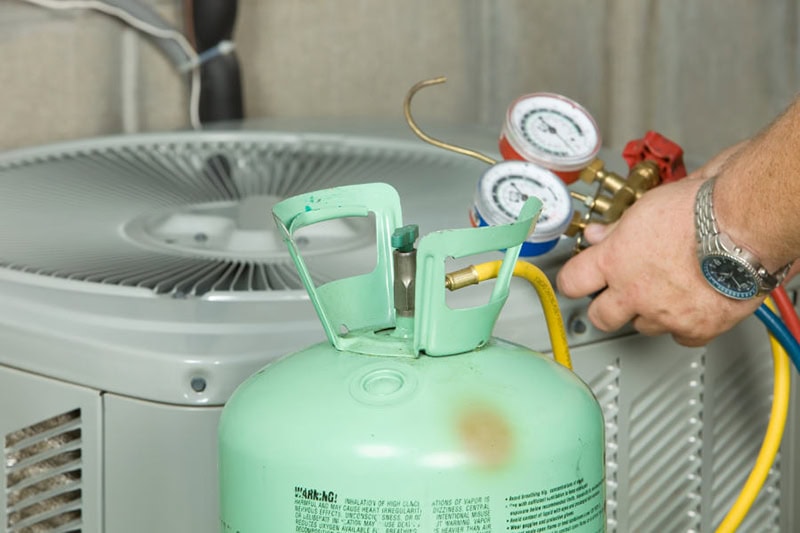What You Need to Know About the Refrigerant Phasedown

The refrigerant currently used in your heat pump or central air conditioner is becoming obsolete, and another transition is already underway.
If your Maryland home’s cooling equipment was manufactured in the early 2000s, it likely uses R-22 refrigerant. This hydrochlorofluorocarbon (HCFC) was commonly used in older HVAC systems but was phased out due to its harmful effects on the ozone layer.
The federal government began the R-22 phaseout in 2010 and banned the production and import of HCFCs entirely by 2020.
Many of these R-22 heating and cooling units are reaching the end of their lifespan. If they have already been replaced, it was most likely with a system manufactured with R-410A.
The Shift From R-22 to R-410A
After 2010, R-410A, a hydrofluorocarbon (HFC), became the replacement for R-22. It doesn’t harm the ozone layer like R-22 does, but it still poses some environmental risks.
R-410A has a high global warming potential (GWP)—studies show that one unit of R-410A can warm the planet 2,088 times more than one unit of carbon dioxide.
The Newest Transition to A2L Refrigerants
Due to their high GWP, R-410A is now being phased down by the U.S. Environmental Protection Agency (EPA), which aims to reduce production and consumption of R-410A by 85% by 2036.
Beginning on January 1, 2025, all newly manufactured HVAC equipment will be required to have an A2L refrigerant.
A2L refrigerants are a new generation of environmentally friendly refrigerants. Classified as “mildly flammable,” they balance safety and efficiency while significantly reducing their impact on climate change. With lower GWP values, A2L refrigerants align with global initiatives to reduce greenhouse gas emissions.
While they require specialized handling and training, A2L refrigerants represent a crucial step toward more sustainable heating and cooling solutions.
Examples of A2L refrigerants include:
- R-454B (Puron Advance™): GWP of 467, currently replacing R-410A in many systems.
- R-32: GWP of 677, already used in some HVAC applications globally.
These refrigerants align with global and federal initiatives to reduce greenhouse gas emissions.
Frequently Asked Questions About Refrigerant Changes
Q: Will I still be able to service my current system with R-410A or R-22?
Yes, but availability will decrease over time. With decades since the start of its phasedown, R-22 is now only available through recycling and reclaimed stock. Supplies of R-410A are expected to be readily available for at least a decade (and likely longer) but will gradually diminish as production is reduced.
If your system needs repairs, our Mission Comfort technicians can help you source refrigerant or explore replacement options.
Q: Is the new refrigerant safe? I’ve heard it’s flammable.
A2L refrigerants like R-454B are classified as “mildly flammable,” but they are safe when handled properly. Technicians receive specialized training to manage these refrigerants, emphasizing the importance of hiring qualified professionals like those at Mission Comfort.
Q. Should I replace my aging HVAC system with one that uses R-410A or one of the new A2L refrigerants?
While R-410A systems are still available, the cost of the refrigerant is expected to rise significantly as its production is phased down. This is a key factor to consider when deciding whether to repair an older system or invest in a new, more efficient one that uses the newer, more environmentally friendly refrigerant.
A2L systems are not necessarily significantly more expensive in the long run. The long-term cost savings from increased efficiency and potentially lower refrigerant costs (once the market stabilizes) could offset any initial price difference.
Consult our experts to find the right option for your home, heating and cooling needs, and your budget.
Q: Will refrigerants change again?
Likely, yes. The HVAC industry will continue to innovate and develop refrigerants with even lower GWP ratings because as global standards evolve, further changes are expected.
Q: What are the benefits of the HFC phasedown?
According to the EPA, the phasedown will decrease HFC production and import in the United States by 85% over the next 15 years.
The EPA says the phasedown will prevent the equivalent of 171 million metric tons of CO₂ emissions annually by 2036 and help limit global warming by up to 0.5°C by 2100.
These changes contribute to a cleaner, more sustainable future.
Ask Us About Refrigerant Changes
Mission Comfort is here to help you navigate these changes. Whether you need repairs, maintenance, or a system upgrade, our experts are trained to work with both legacy and next-generation refrigerants. Contact us at 301-450-8414 or request service online to learn more about your options in Brandywine, MD.